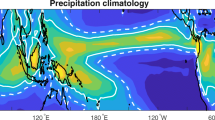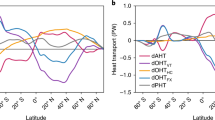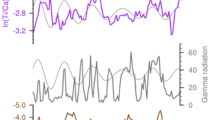Abstract
The intertropical convergence zone (ITCZ) in atmospheric general circulation models (coupled to slab ocean) shift southwards in response to northern extratropical cooling. Previous studies have demonstrated the utility of diagnosing the atmospheric energy fluxes in interpreting this teleconnection. This study investigates the nature of global energy flux changes in response to North Atlantic high latitude cooling applied to the Community Atmosphere Model version 3 coupled to a slab ocean, focusing on key local and remote feedbacks that collectively act to alter the energy budget and atmospheric energy transport. We also investigate the relative roles of tropical sea surface temperature (SST) and energy flux changes in the ITCZ response to North Atlantic cooling. Using a radiative kernel technique, we quantify the effects of key feedbacks—temperature, cloud and water vapor, to the top-of-the-atmosphere radiative flux changes. The results show only partial local energy flux compensation to the initial perturbation in the high latitudes, originating from the negative temperature feedback and opposed by positive shortwave albedo and longwave water vapor feedbacks. Thus, an increase in the atmospheric energy transport to the Northern extratropics is required to close the energy budget. The additional energy flux providing this increase comes from top-of-the-atmosphere radiative flux increase over the southern tropics, primarily from cloud, temperature and longwave water vapor feedbacks, and largely as a consequence of increased deep convection. It has been previously argued that the role of tropical SST changes was secondary to the role played by the atmospheric energy flux requirements in controlling the ITCZ shifts, proposing that the SST response is a result of the surface energy budget and not a driver of the precipitation response. Using a set of idealized simulations with the fixed tropical SSTs, we demonstrate that the ITCZ shifts are not possible without the tropical SST changes and suggest that the tropical SSTs are a more suitable driver of tropical precipitation shifts compared to the atmospheric energy fluxes. In our simulations, the ITCZ shifts are influenced mainly by the local (tropical) SST forcing, apparently independent of the actual high latitude energy demand.












Similar content being viewed by others
References
Bonan GB, Oleson KW, Vertenstein M, Levis S, Zeng X, Dai Y, Dickinson RE, Yang ZL (2002) The land surface climatology of the Community Land Model coupled to the NCAR Community Climate Model. J Clim 15:3123–3149
Broccoli AJ, Dahl KA, Stouffer RJ (2006) Response of the ITCZ to Northern Hemisphere cooling. Geophys Res Lett 33:L01702. doi:10.1029/2005GL024546
Caballero R (2007) Role of eddies in the interannual variability of Hadley cell strength. Geophys Res Lett 34:L22705. doi:10.1029/2007GL030971
Caballero R, Anderson BT (2009) Impact of midlatitude stationary waves on regional Hadley cells and ENSO. Geophys Res Lett 36:L17704. doi:10.1029/2009GL039668
Chang P, Saravanan R, Ji L, Hegerl GC (2000) The effect of local sea surface temperatures on the atmospheric circulation over the tropical Atlantic sector. J Clim 13:2195–2216
Cheng W, Bitz CM, Chiang JCH (2007) Adjustment of the global climate to an abrupt slowdown of the Atlantic meridional overturning circulation. In: Schmittner A, Chiang JCH, Hemming SR (eds) Ocean circulation: mechanisms and impacts. Geophysics Monograph Series 173. AGU, Washington, pp 295–313
Chiang JCH, Biasutti M, Battisti DS (2003) Sensitivity of the Atlantic Intertropical Convergence Zone to Last Glacial Maximum boundary conditions. Paleoceanogr 18(4):1094. doi:10.1029/2003PA000916
Chiang JCH, Bitz CM (2005) Influence of high latitude ice cover on the marine Intertropical Convergence Zone. Clim Dyn 25:477–496. doi:10.1007/s00382-005-0040-5
Chiang JCH, Kushnir Y, Giannini A (2002) Deconstructing Atlantic Intertropical Convergence Zone variability: influence of the local cross-equatorial sea surface temperature gradient and remote forcing from the eastern equatorial Pacific. J Geophys Res Atmos 17:4004. doi:10.1029/2000JD000307
Chiang JCH, Cheng W, Bitz CM (2008) Fast teleconnections to the tropical Atlantic sector from Atlantic thermohaline adjustment. Geophys Res Lett 35:L07704. doi:10.1029/2008GL033292
Collins WD et al (2004) Description of the NCAR Community Atmosphere Model (CAM3). Tech. Note NCAR/TN‐464 + STR, National Centre for Atmospheric Research, Boulder
Collins WD et al (2006) The formulation and atmospheric simulation of the Community Atmosphere Model version 3 (CAM3). J Clim 19(11):2144–2161
Cvijanovic I, Langen PL, Kaas E (2011) Weakened atmospheric energy transport feedback in cold glacial climates. Clim Past 7:1061–1073. doi:10.5194/cp-7-1061-2011
Dubois N, Kienast M, Kienast SS, Normandeau C, Calvert SE, Herbert TD, Mix AC (2011) Millennial-scale variations in hydrography and biogeochemistry in the eastern equatorial Pacific over the last 100 kyr. Quat Sci Rev 30:210–223
Fleitmann D et al (2003) Holocene forcing of the Indian monsoon recorded in a stalagmite from southern Oman. Science 300:1737–1739. doi:10.1126/science.1083130
Kang SM, Held IM (2011) Tropical precipitation, SSTs and the surface energy budget: a zonally symmetric perspective. Clim Dyn. doi:10.1007/s00382-011-1048-7
Kang SM, Held IM, Frierson DMW, Zhao M (2008) The response of the ITCZ to extratropical thermal forcing: idealized slab-ocean experiments with a GCM. J Clim 21:3521–3532. doi:10.1175/2007JCLI2146.1
Kang SM, Frierson DMW, Held IM (2009) The tropical response to extratropical thermal forcing in an idealized GCM: the importance of radiative feedbacks and convective parameterization. J Atmos Sci 66:2812–2827. doi:10.1175/2009JAS2924.1
Kienast M, Steinke S, Stattegger K, Calvert SE (2001) Synchronous tropical South China Sea SST change and Greenland warming during deglaciation. Science 291:2132–2134
Kienast M, Kienast SS, Calvert SE, Eglinton TI, Mollenhauer G, Francois R, Mix AC (2006) Eastern Pacific cooling and Atlantic overturning circulation during the last deglaciation. Nature 443:846–849
Kim HK, Lee S (2001) Hadley cell dynamics in a primitive equation model. Part II: nonaxisymmetric flow. J Atmos Sci 58:2859–2871
Koutavas A, Sachs JP (2008) Northern timing of deglaciation in the eastern equatorial Pacific from alkenone paleothermometry. Paleoceanography 23:PA4205. doi:10.1029/2008PA001593
Lea DW, Pak DK, Peterson LC, Hughen KA (2003) Synchronicity of tropical and high-latitude Atlantic temperatures over the last glacial termination. Science 301:1361–1364
Lea DW, Pak DK, Belanger CL, Spero HJ, Hall MA, Shackleton NJ (2006) Paleoclimate history of Galapagos surface waters over the last 135,000 yr. Quat Sci Rev 25:1152–1167
Levitus S (1982) Climatological atlas of the world ocean. NOAA Professional Paper 13, U.S. Government Printing Office, Rockville
Lindzen RS, Hou AY (1988) Hadley circulations for zonally averaged heating centered off the equator. J Atmos Sci 45:2416–2427
Lindzen RS, Nigam S (1987) On the role of sea-surface temperature gradients in forcing low level winds and convergence in the tropics. J Atmos Sci 44:2440–2458
Mahajan S, Saravanan R, Chang P (2011) The role of the wind-evaporation-sea surface temperature (WES) feedback as a thermodynamic pathway for the equatorward propagation of high-latitude sea ice-induced cold anomalies. J Clim 24:1350–1361. doi:10.1175/2010JCLI3455.1
Oleson KW et al (2004) Technical description of the Community Land Model (CLM). Tech. Note NCAR/TN‐461 + STR, National Center for Atmospheric Research, Boulder
Peterson LC, Haug GH (2006) Variability in the mean latitude of the Atlantic Intertropical Convergence Zone as recorded by riverine input of sediments to the Cariaco Basin (Venezuela). Palaeogeogr Palaeoclimatol Palaeoecol 234:97–113. doi:10.1016/j.palaeo.2005.10.021
Peterson LC, Haug GH, Hughen KA, Rohl U (2000) Rapid changes in the hydrologic cycle of the tropical Atlantic during the last glacial. Science 290:1947–1951. doi:10.1126/science.290.5498.1947
Shell KM, Kiehl JT, Shields CA (2008) Using the radiative kernel technique to calculate climate feedbacks in NCAR’s community atmospheric model. J Clim 21:2269–2282. doi:10.1175/2007JCLI2044.1
Soden BJ, Held IM, Colman R, Shell KM, Kiehl JT, Shields CA (2008) Quantifying climate feedbacks using radiative kernels. J Clim 21:3504–3520. doi:10.1175/2007JCLI2110.1
Su H, Neelin JD (2002) Teleconnection mechanisms for tropical Pacific descent anomalies during El Nino. J Atmos Sci 59:2682–2700
Timmermann A, Krebs U, Justino F, Goosse H, Ivanochko T (2005) Mechanisms for millennial-scale global synchronization during the last glacial period. Paleoceanography 20:4008
Timmermann A et al (2007) The influence of a collapse of the meridional circulation of the Atlantic on ENSO. J Clim 20:4899–4919. doi:10.1175/JCLI4283.1
Walker CC, Schneider T (2006) Eddy influences on Hadley circulations: simulations with an idealized GCM. J Atmos Sci 63:3333–3350. doi:10.1175/JAS3821.1
Wang YJ et al (2008) Millennial- and orbital-scale changes in the East Asian monsoon over the past 224,000 years. Nature 451:1090
Wong T, Stackhouse PW Jr, Kratz DP, Wilber AC (2009) Earth radiation budget at top-of-atmosphere. In: State of the climate in 2008, Bull Am Meteorol Soc 90(8):S1–S196
Wu L, Li C, Yang C, Xie S-P (2008) Global teleconnections in response to a shutdown of the Atlantic meridional overturning circulation. J Clim 21:3002–3019. doi:10.1175/2007JCLI1858.1
Xie S-P (1999) A dynamic ocean-atmosphere model of the tropical Atlantic decadal variability. J Clim 12:64–70
Xie S-P, Carton JA (2004) Tropical Atlantic variability: patterns, mechanisms, and impacts. In: Wang C, Xie S-P, Carton JA (eds) Earth climate: the ocean-atmosphere interaction, Geophysical Monograph. AGU, Washington
Yoshimori M, Broccoli AJ (2009) On the link between Hadley circulation changes and radiative feedback processes. Geophys Res Lett 36:L20703. doi:10.1029/2009GL040488
Zelinka M, Hartmann DL (2011) Climate feedbacks and their implications for poleward energy flux changes in a warming climate. J Clim. doi:10.1175/JCLI-D-11-00096.1
Acknowledgments
The authors acknowledge the support of Danish National Research Foundation, the Office of Science (BER), US Department of Energy (Award No. DE-FG02-08ER64588), and the National Science Foundation (Award No. ATM-0628628 and OCE-0902774). We thank Karen Shell and Alexandra Jonko for providing their radiative kernels and their assistance in its use, to Inez Fung on her invaluable comments and collaboration support and to Eigil Kaas and Peter L. Langen on their thoughtful suggestions. We are grateful to Andrew Friedman, Shih-Yu Lee, Yuwei Liu and Ching-Yee Chang on stimulating discussions.
Author information
Authors and Affiliations
Corresponding author
Rights and permissions
About this article
Cite this article
Cvijanovic, I., Chiang, J.C.H. Global energy budget changes to high latitude North Atlantic cooling and the tropical ITCZ response. Clim Dyn 40, 1435–1452 (2013). https://doi.org/10.1007/s00382-012-1482-1
Received:
Accepted:
Published:
Issue Date:
DOI: https://doi.org/10.1007/s00382-012-1482-1




